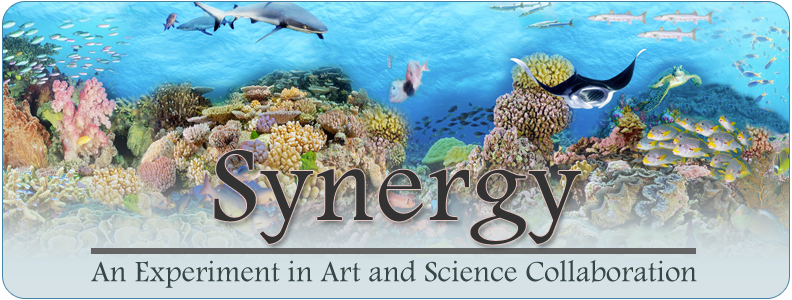Indo-Pacific Coral Reefs
REGIME SHIFT / ANTHROPOGENIC IMPACTS
In my collaboration, with marine scientists at Woods Hole Oceanographic and MIT, I have vicariously traveled to the most remote islands in the Indo- Pacific to retell a Malthusian story of the coral life cycle in equilibrium, degradation, transformation, acidification, and adaptation. Coral reef biomes are biodiverse. A single coral reef system may have hundreds of species of marine algae and thousands of fish and invertebrate animal species within the coral reef zonation. The coral reef is alive with the raucous mix of sighs, beats, clicks, grunts, and calls from fish and other species. Coral, plants and animal species are uniquely adapted to each coral reef zone and display dizzying colors, patterns, shapes and behaviors.
Humans are affecting coral reefs around the globe both directly, through coastal development and over-fishing, and indirectly, through climate change with ocean warming and acidification. The degradation of coral reefs results in regime change—equilibrium shifts in a healthy reef leading to decline or adaptation. Stress can cause corals to expel their symbiotic zooxanthellae algae, a process known as bleaching, which can lead to coral death. In an altered state, the formerly bio-diverse coral reef is shrouded with algae. Sea urchins feast to bare skeleton. Nature can show resilience, transforming over very long periods of time, as in some reefs in Papua New Guinea to volcanic vent conditions to display regime change from a coral decline to an algae state to sea grass with acidification. Over centuries of exposure to warm and acidic water at Rock Reef, Palau, biodiverse coral reefs have developed through adaptation and may hold the genetic key to repopulate a warmer and acidic sea in future. However, if stressful ocean changes occur with high rapidity, coral reefs may not be able to adapt in time without our help.
Art + Science Collaboration
The Indo-Pacific Coral Reefs Regime Change exhibit represents an ongoing collaboration between environmental artist, Joseph Ingoldsby-Landscape Mosaics and marine scientists at Woods Hole Oceanographic Institution and MIT. Team members, Katie Shamberger, Hannah Barkley, Alice Alpert, and Emily Moberg have provided insights, visual files, and published papers for review and assimilation. Katie Shamberger, Hannah Barkley and I collaborated in honing the Indo-Pacific Regime Change Narrative to reflect the nuanced interpretations of scientific nomenclature while allowing a level of descriptive poetic language.
Special thanks are extended to Katharina Fabricius and Laetitia Plaisance for their research on the impacts of ocean acidification on coral reef biodiversity with the Australian Institute of Marine Science and the Smithsonian Institution. Their work is referenced within the Papua, New Guinea acidification panel.
Joseph Ingoldsby
Landscape Mosaics
http://www.landscapemosaics.com/
http://josephemmanuelingoldsby.com/
Coral Reef Climate Change Artwork:
Ocean Stories - A Synergy of Art & Science Links:
|

